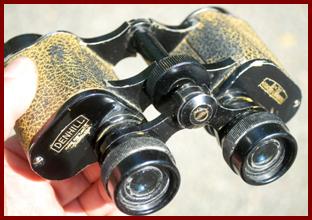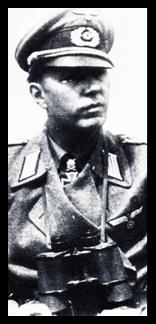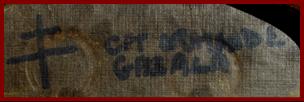
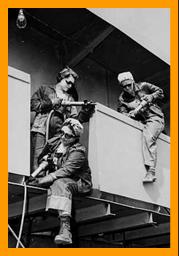


|
OTHER BINOCULARS #13 & OPTICAL SIGHTS (MOSTLY MILITARY) |
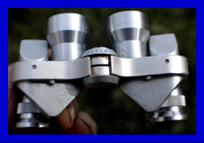
|
Japanese External Reverse Porro Prism Binoculars. WEBSITE MUSEUM |
|
FOR GERMAN WWII BINOCULAR and OPTICAL MANUFACTURER CODES |

|
WWII Optisch Werk G Rodenstock Dienstglas eso 6x30 German Military binoculars w/reticule |
|
My WWII 6x30 German dienstglas military binoculars carry the eso wartime code of Optisch Werk G Rodenstock, and are standard pattern WWII German military binoculars with right ocular reticule/grid. My understanding is that these were brought back home to the USA by a member of the US Army Air Force 79th fighter group, Staff Sergeant John K Browning of Baltimore Maryland. The 79th fighter group was stationed in Egypt, Lybia, Tripoli, Tunisia, Malta, Sicily, Italy, and France during WWII, and then in Linz Austria during the occupation, and flew P40 and P47 Thunderbolt fighters. The binoculars are engraved with a letter and 12 digit inscribed Maryland drivers license number, a common anti theft practice in the 1950’s & 1960’s.The “KF ” (K ätelfest) marking indicates the use of late war cold weather Invarol lubricant, which was a product developed to cope with the extreme cold of the German invasion of Russia. This is another example of where binoculars (as an object or artifact) have interesting stories to reveal of their past. |
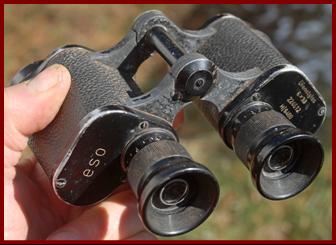
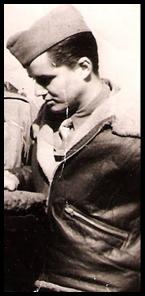
|
Owner S/Sgt John K. Brownley 79th fighter group USAF |
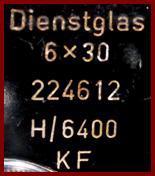

|
Chinese (7x50 sized) 8 oz Realistic Faux Booze Smuggle Binoculars |
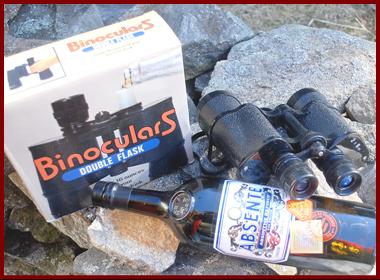
|
I guess no sports venue actually offers any Absinthe in the stands, or that many fans try to sneak Absinthe into US ball games inside fake binoculars ??? I do like binoculars, even fake ones... and I do sort of like absinthe... enough to own both. Hence photo. But I find ball games dead boring. Oh well... |
|
I make no secret of liking the insights that binoculars can give into human behavior. U.S. outdoor commercial sports venues (baseball, football) tend to license alcohol sales to concessionaires and therefore ban attendees bringing their own booze with them. So these hollow and fake but quite realistic double flask “binoculars” are for people who want to smuggle their own alcohol in with them to avoid the overpriced and limited choice of booze that the venue wants all attendees to buy. Smuggle choice? |
|
Romanian Army I.O.R. (Întreprinderea Optică Română/ Romanian Opical Enterprises) BC (Binoclu Camp/ Binoculars Field) (Model) N. 4 8x30 Military binoculars with very low serial number of 104 |
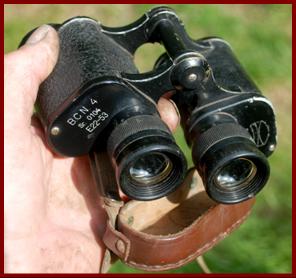
|
My 8x30 Romanian military binoculars were made by I.O.R. (Întreprinderea Optică Română) in Romania. They are marked B.C. (Binoclu Camp/ field binoculars) N. (Num ă r/ number) 4 . They have an extremely low serial number of 0104. They have a right ocular reticule/ ranging grid. I am not presently cognitive of when this model was produced. The 53 might plausibly indicate 1953, but this is purely speculative. Knowledgeable additional information welcome. |
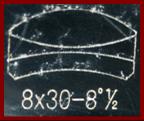
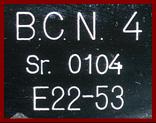
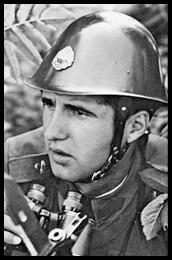
|
Romanian soldier with binoculars |
|
My 1977 7x40 Romanian military binoculars were made by I.O.R. (Întreprinderea Optică Română), in Vadala Romania. This was a Romanian optical firm established in 1935. These binoculars used lenses manufactured by the German firm Schott Glaswerk GmbH, which were T3 magnesium fluoride coated. The left hand side of these binoculars has a fold out IR filter and an IR detector that seems to be similar to the IR detector that is used on East German Carl Zeiss NVA binoculars. The objective lens covers contain accessory yellow filters. ( Thanks to Sturm Handels GmbH for picking me out a nice example to purchase to present here). |
|
1977 Romanian Army I.O.R. (Întreprinderea Optică Română) Vadala 7x40 Military Binoculars w/ IR Filter |
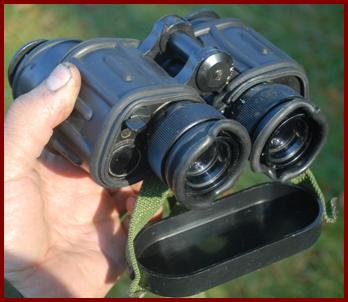
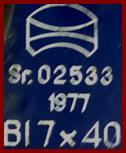


|
IR detector |
|
1927 Russian Podolsk Optical factory 6x30 Military Binoculars 14776 |
|
The Russian Podolsk Optical factory only existed from 1926 to 1928, and was located in outside Moscow in a former Singer sewing machine factory. It was the successor to the main Artillery Directorate Factory, which was the successor to the previous Zeiss and Goerz Russian factories. Surviving binoculars seem uncommon, and my 6x30 binoculars serial No.14776 have somewhat defaced markings suggesting having been German soldier captured binoculars. (The binoculars website fernglasmuseum.at has a similar but slightly different 1926 example with serial No. 13099). Some markings are not known by me (Russian translation help welcome). |
|
Canadian Imported faux “ Dienstglas ” faux “ Air Force ” Marked Japanese Binoculars. |
|
Late Canadian optical importer Walter Carsen and wife Clementine Nalm conducted business as W. Carsen & Co. Ld. from 1946-1962 (the optics firm continued afterwards was sold to other owners). He was a German Jew who fled Germany in 1938 to start an optical import business in London. (Carsen’s parents were executed in Auschwitz). Carsen was arrested in 1940 in England as an enemy alien, and shipped to a Canadian prison camp, where he gained his release in 1943 by joining a war factory grinding military optical lenses in Toronto. He started his Canadian optical import business in 1946, and in 1949 gained exclusive Canadian distribution rights to Japanese Olympus optical products. Hostile to German firms, but recognizing returning Canadian soldiers viewed German binoculars as superior, Walter Carsen in the 1950’s made up binoculars brand names with combined parts of German firm names and/ or towns (Carl Wetzlar for Carl Zeiss Jena/ Leitz Wetzlar for example) on the Japanese binoculars he imported for the Canadian consumer market. He also marked some to give a false impression of being military (Carl Wetzlar Air Force for example). In addition to his fully documented Carl Wetzler brand, I am convinced that the scores of other faux German sounding names on Japanese binoculars which flooded the Canadian market in the 1950’s were also Walter Carsen. His intent was to profit by deceiving Canadian consumer’s perceptions by manipulating brand name marking for more desirability, and all those names are still deceiving people 50+ years later. But that is really just marketing, like the branding of binoculars with “Super”, “ Gold”, or the markings like “day night” and “triple tested” other companies used. |
|
North American Civilian Binoculars with AM Radio Cases for Ball Games, St. Moritz , Carl Wetzlar |
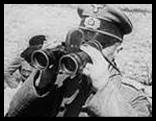
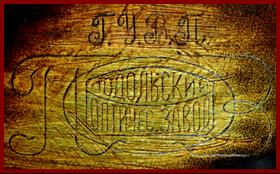
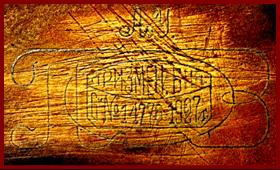
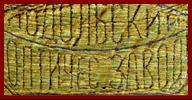
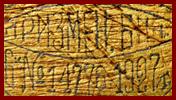



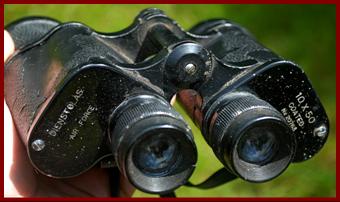
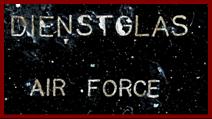
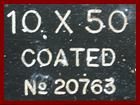
|
“DIENSTGLAS” “AIR FORCE” branded Japanese produced 10X20 binoculars. |
|
Intended to suggest being German and being military. But they are not. |
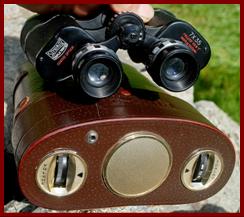


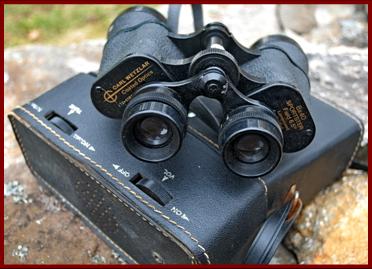
|
Binoculars with AM radio cases fit a time period (1950’s/ 1960’s) when AM radio in the United States and Canada broadcast professional outdoor sports games (baseball, football) with a constant stream of commentary. Some sports fans actually attending games wanted to hear that while watching the game with their binoculars, so brought their binoculars radio case combination sets and listened either on the speaker or more privately on an earphone. This may also apply to indoor games like basketball and hockey. |


|
My Bino-Dio transistor radio case and St. Moritz 7x35 binoculars were imported into the USA by Manhattan Novelty Corporation of New York City, USA, who held the US trademark for St Moritz for binoculars 1953-1988. My St. Moritz binoculars were assembled by JB250/ Fujimori Optical Co., Ltd. Of Japan. The radio still works. |
|
My transistor radio case and Carl Wetzlar 8x40 Sportster binoculars were imported into Canada by W. Carsen & Co. Ltd of Ontario Canada. My Carl Wetzlar binoculars were assembled JB206 / Fujita Koki Seisakuio of Japan with frame made by JE9 / Sato Kogaku Kogyo Co. Ltd. of Japan. Carl Wetzer was a brand name created to invoke German brands Carl Zeiss Jena/ E. Leitz Wetzlar by Walter Carsen (see dienstglas Air Force binoculars above). The radio still works. |

|
WWII Optick é Podniky (Optical Enterprise) G. Rodenstock German made 6x27 Slovak Republic? Army military polni kuk á tko binoculars |
|
I believe my Rodenstock binoculars are German manufactured Slovak Republic binoculars. The Slovak Republic was created in March 1939 as a German supported entity, along with the Protectorate of Bohemia and Moravia, in the segmentation of Czechoslovakia. Slovak Republic military battalions fought alongside the Germans in the Poland campaign, and 45,000 Slovak Republic Army troops fought alongside German units in the Russian campaign. I think my Slovak language marked “Optick é Podniky” (Optical Enterprise) G. Rodenstock “Mnichov” (Munich) 6x27 “polni kuk á tko” (field glasses?) were made under contract by the German firm Optiche Werke G. Rodenstock, probably in 1939 or 1940, to equip the Slovak Republic Army. |
|
1950’s Denhill French made 8x32 self commemorative binoculars of Free French unit activity |
|
I believe these post WWII binoculars were a self commemorative item by a French vet Capt Grimnde who had served in the 1st div Francaise Libre (Free French brigade) during WWII, who was living in the UK after the war. Denhill binoculars were French made binoculars that J.A. Davis imported under their Denhill brand name into the UK starting in 1951. The Gazla marking on the case is the battle of Gazla fought by the Free French in Lybia in May/ June 1942, and the cross is the mark of the 1st div.. The UK broad arrow markings are self scratched rather than being govt. stamped, but free French units were organized and equipped by the British, so broad arrow markings would have been what would have been on a captain’s issue binoculars during the war. The sand paint is presumably a nod to Lybian experience. |
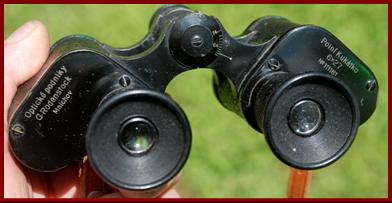


|
Ca. 1960’s British Wray Wraylite Armia Krajowa Shuzba Zwyciestwu Polski (Home Army Shuzba to the Victory of Poland) 8x30 Commemorative Presentation Binoculars |
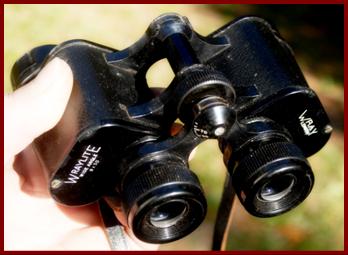

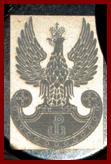
|
Wray Optical Works Ltd. (Bromley Kent) existed 1850-1971, when it closed because the value of selling the physical assets exceeded the value of running the company. I believe this Wraylite model to be from the mid 1960’s. Armia Krajowa Tuuzba Zwyciestwu Polski (home army for the victory of the Polish) was the Polish resistance organization in German occupied Poland 1942-1945, and this seems to be a Wray Commemorative model, given as a retirement gift to an employee W.S. Sanders by Pilkington Brothers Ltd, who is a UK glass manufacturer in Lancashire. |

|
“PRESENTED BY PILKERTON BROTHERS LIMITED TO W. S. SANDERS AFTER 45 YEARS SERVICE” |
|
Military service was the major life event for many, and commemorative markings (battles, units, theaters of war etc.) are seen on many veteran items (helmets, packs, trunks, etc) and on many non military jackets, caps, license plates, mugs. And binoculars. |
